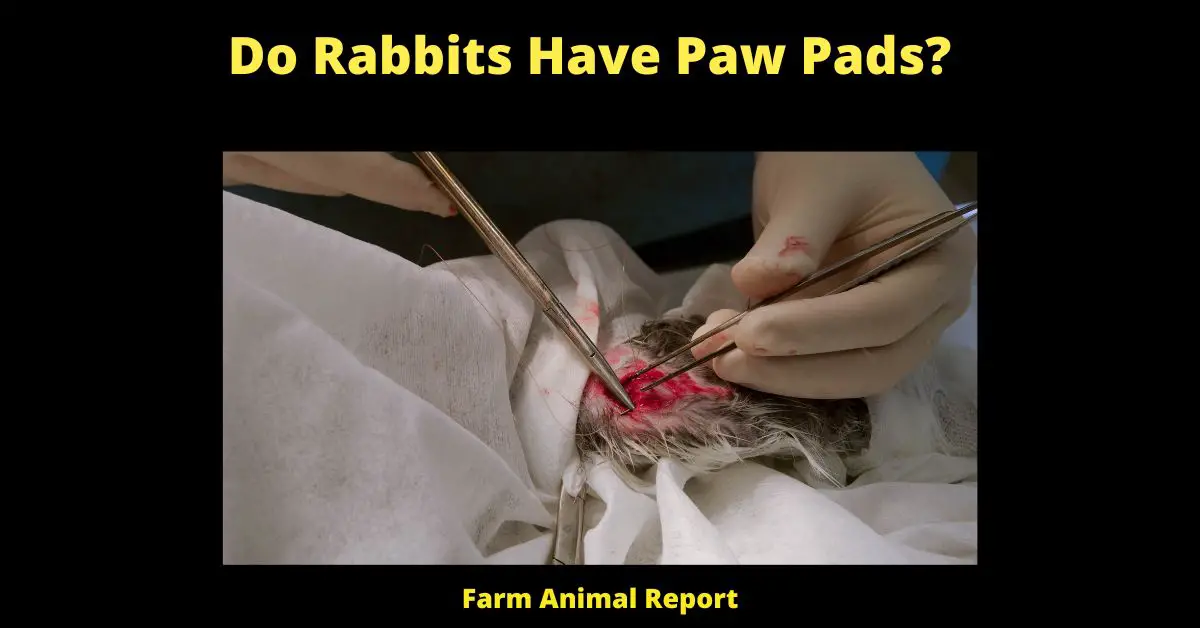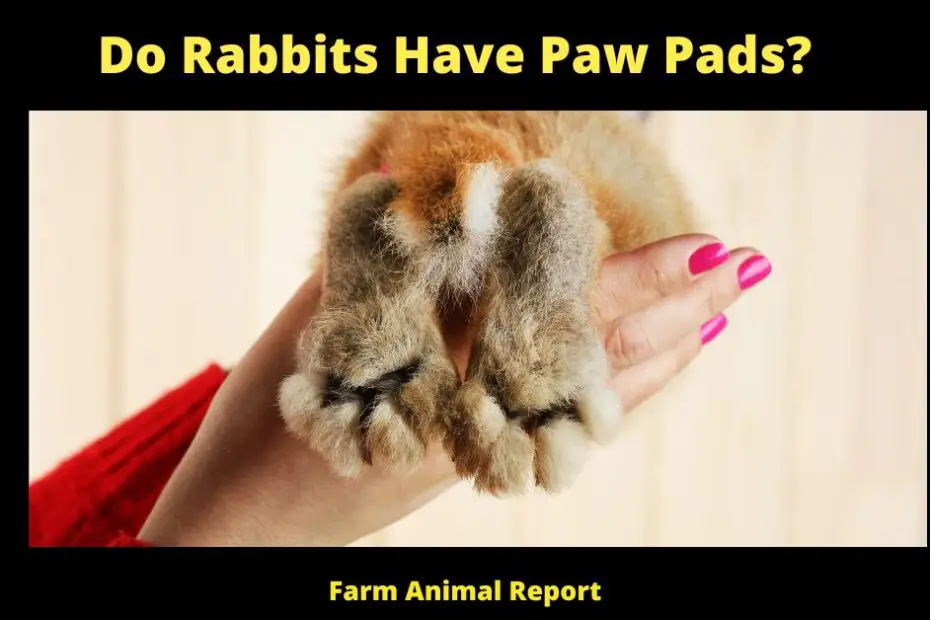Though they don’t look like it, rabbits do have paw pads. These are thickened areas of skin that help to cushion the bones and joints in the feet and provide traction when the rabbit is running or jumping.
The pads also help to protect the delicate toenails from getting chipped or broken. In some breeds of rabbits, the paw pads may be slightly visible, while in others they are completely hidden by fur. Regardless of their appearance, paw pads play an important role in a rabbit’s overall health and wellbeing.
Do Rabbits Have Paw Pads?
Rabbits are adorable creatures that many people enjoy keeping as pets. But did you know that they have paw pads? In this blog post, we will take a closer look at the anatomy of a rabbit’s paw and discuss what these paw pads do for them. Stay tuned!

The Anatomy of a Rabbit’s Foot?
The Parts of a Rabbit’s foot Consist of:
- The dewclaw: This is a thumb-like claw that is located on the inner side of the paw.
- The metacarpals: These are the bones that make up the main part of the foot.
- The phalanges: These are the bones that make up the toes.
- The pads: As we mentioned before, these are thickened areas of skin that help to cushion and protect the bones and joints in the feet.
Now let’s take a closer look at each of these parts…
The Dewclaw
As you can see in this diagram, rabbits have a thumb-like claw on their innermost toe. This claw is called a dewclaw and it helps them to grip objects and keep their balance. While some rabbits may have dewclaws on all of their toes, others may only have them on their front paws. Do Rabbits Have Paw Pads?
Check Out Amazon for Resources about Breeding Rabbits
The Metacarpals
These are the bones that make up the main part of the foot. They are located between the phalanges (toes) and the wrist. In rabbits, there are typically five metacarpals in each paw.
The Phalanges
These are the bones that make up the toes. In rabbits, there are typically four phalanges in each toe (excluding the dewclaw). The first phalanx is attached to the metacarpal bone and the second and third phalanges are attached to each other. The fourth phalanx, or distal phalanx, is the claw.
The Pads
As we mentioned before, these are thickened areas of skin that help to cushion and protect the bones and joints in the feet. Paw pads come in all shapes and sizes, but they are typically round or oval-shaped. Some paw pads may be slightly visible, while others may be completely hidden by fur. Regardless of their appearance, paw pads play an important role in a rabbit’s overall health and wellbeing.
What Do Paw Pads Do?
Paw pads serve several important functions in rabbits. First and foremost, they help to cushion the bones and joints in the feet. This helps to prevent injuries when the rabbit is running or jumping. Additionally, the pads help to protect the delicate toenails from getting chipped or broken. In some breeds of rabbits, the paw pads may also be slightly visible, which can add to their overall appearance.
Do All Rabbits Have Paw Pads?
Yes, all rabbits have paw pads. However, some paw pads may be more hidden than others due to the length of fur. For example, in breeds like the Angora rabbit, the fur is so long that the paw pads are not typically visible. Regardless of their appearance, all rabbits have paw pads and they play an important role in their overall health and wellbeing.
What do the Paw Pads do for Rabbits?
A Rabbits Paw pad looks like a thickened area of skin that helps to cushion and protect the bones and joints in their feet. It also helps to prevent injuries when the rabbit is running or jumping, as well as protecting their delicate toenails. In some breeds, the paw pads may be slightly visible due to the length of fur, while in others they are completely hidden. All rabbits have paw pads and they play an important role in their overall health and wellbeing.
How to tell if your Rabbit’s Paw Pads are Healthy?
There are a few things you can look for to tell if your rabbit’s paw pads are healthy. First, take a look at the color of the pads. They should be pink or slightly brown in color. If they are any other color, it could be an indication that something is wrong.
Additionally, you should feel for any lumps or bumps on the surface of the pads. These could be indicative of an injury or infection. Finally, make sure the pads are not cracked or dry. If they are, this could lead to further problems down the road.
If you notice any changes in your rabbit’s paw pads, it is important to contact a veterinarian as soon as possible. While most Paw Pad problems can be easily resolved with proper treatment, they can become serious if left untreated. So, it is always better to err on the side of caution and get your rabbit to the vet as soon as possible.

What are Common problems with Rabbit Paw Pads?
Some of the most common problems that can affect rabbit paw pads include injuries, infections, and inflammation. Injuries can occur if the rabbit is stepped on or if they fall from a height. Infections can happen if the pads are cracked or dry, allowing bacteria to enter the skin. Inflammation can be caused by allergies or irritants, and it can lead to further problems if left untreated.
What are the common Causes of Paw Problems in Rabbits?
There are many potential causes of paw problems in rabbits, including
- Injuries
- Infections
- Allergies
Injuries can occur from sharp objects, such as nails or wire cages. Infections can develop from bacteria or fungi that enter the body through cuts or open wounds. Allergies can be caused by environmental factors, such as pollen or chemicals.
Treatment for paw problems will vary depending on the cause. Injuries may require wound care, antibiotics, or surgery. Infections may need to be treated with antifungal or antibacterial medications.
Allergies may be managed with antihistamines or avoidance of the offending substance. If you think your rabbit has a paw problem, contact your veterinarian for diagnosis and treatment options.
What are the best Walking Surfaces for Rabbits to have Healthy Pads?
Rabbits need to have access to a variety of walking surfaces in order to keep their paw pads healthy. A diet rich in hay and fresh vegetables will also help to keep their pads healthy and free from injury.
Some good walking surfaces for rabbits include:
- Grass
- Packed dirt
- Sand
- Smooth rocks or pebbles
- Wooden floors or ramps
- Carpeted areas (avoiding any area with loops or tufts)
If you are not able to provide your rabbit with a variety of walking surfaces, then you should at least provide them with a piece of cardboard or wood that they can use to scratch and rub their paw pads on. This will help to keep their pads healthy and free from injury.
9 Tips for Keeping your Rabbit’s Paw Pads Healthy?
- Rabbits are creatures of habit and like to stick to their routines. This can make them seem a bit aloof, but it also means they’re very easy to care for. One area you’ll need to pay close attention to is your rabbit’s paw pads. Here are nine tips for keeping them healthy:
- Inspect your rabbit’s paw pads regularly and look out for any redness, swelling, or cuts. If you see anything unusual, take your rabbit to the vet right away.
- Keep your rabbit’s nails trimmed. Long nails can cause pain and make it difficult for your rabbit to walk properly. You can trim their nails yourself or take them to a professional groomer.
- Make sure your rabbit has plenty of soft bedding to lounge on. This will help prevent calluses and soreness.
- Give your rabbit a massage! Gently rub their paw pads with your fingers to increase circulation and flexibility.
- Put a little Vaseline on their paw pads if they’re cracked or dry. This will help heal them and keep them healthy.
- Add some toys and obstacles to their cage or play area so they can get a good workout. This includes things like tunnels, bridges, and ramps.
- Take your rabbit outside for a walk on grassy areas. Walking helps keep their paw pads supple and strong. Just be sure not to overdo it – start with short walks and gradually increase the distance.
- If your rabbit lives indoors, try putting them on a treadmill! This is a great way to get them some exercise without having to go outside.
- By following these tips, you can help keep your rabbit’s paw pads healthy and prevent any problems in the future. Do you have any other tips to share? Let us know in the comments!
Do Wild Rabbits have Paw Pads?
Yes, wild rabbits have paw pads. This helps protects their feet from the rough terrain and provides insulation in cold weather. The pads also help them grip the ground when they’re running and jumping. If you look closely, you’ll see that the pads are slightly different colors – this is because the bottom of the pad is darker than the top.
This helps camouflage the rabbit from predators. Wild rabbits typically have four to five toes on each foot, with each toe having its own pad. The size and shape of a wild rabbit’s paw pads may vary depending on the species.
For example, desert-dwelling rabbits have larger, rounder paws to help them move across the sand without sinking down too far. Mountain-dwelling rabbits have smaller, more compact paws that help them grip the icy ground.
No matter what the terrain, though, all wild rabbits have paw pads to help them get around safely.
Do Pet Rabbits have Paw Pads?
Yes, pet rabbits have paw pads. These provide protection for their feet and help insulate them in cold weather. The pads also help them grip the ground when they’re running and jumping. Just like wild rabbits, pet rabbits typically have four to five toes on each foot, with each toe having its own pad.
The size and shape of a pet rabbit’s paw pads may vary depending on the breed. For example, desert-dwelling rabbits have larger, rounder paws to help them move across the sand without sinking down too far.
Mountain-dwelling rabbits have smaller, more compact paws that help them grip the icy ground. No matter what the terrain, though, all pet rabbits have paw pads to help them get around safely.
Do Hares have Paw Pads?
Yes, hares have paw pads. This helps protects their feet from the rough terrain and provides insulation in cold weather. The pads also help them grip the ground when they’re running and jumping. If you look closely, you’ll see that the pads are slightly different colors – this is because the bottom of the pad is darker than the top.
Final Thoughts – Do Rabbits Have Paw Pads?
All Rabbits, both Wild and Pets have Paw Pads. Paw pads protect the bottom of the feet from getting hurt and also help grip surfaces to prevent slipping. The color of a Rabbit’s paw pads can vary depending on the breed but are typically some shade of pink or black.





